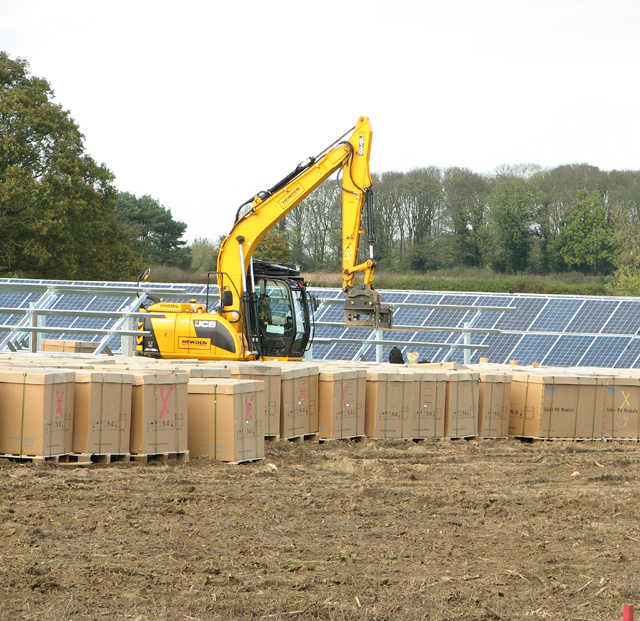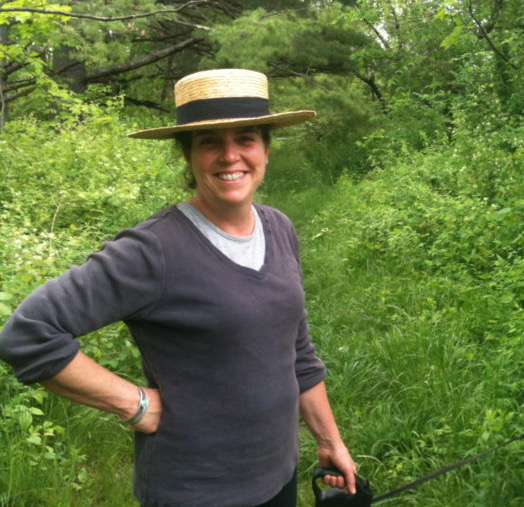Opinion: Amherst Needs A Solar Siting Bylaw

A solar farm under construction in the UK. Photo: Geograph (CC BY_SA 2.0)

I am writing, as a town resident, in support of the temporary moratorium on the permitting and approval for large-scale mounted solar photovoltaic installations (proposed Article 16 of the town bylaws). We need to plan first with a solar assessment and develop a comprehensive solar array bylaw, and only then grant permits for large-scale solar arrays.
Right now, our zoning bylaw has one sentence on energy facilities—in contrast to five pages of sign requirements. The Zoning Board of Appeals (ZBA), Planning Director, Building Commissioner and Energy and Climate Action Committee all have noted the critical need for more study and regulation of large-scale solar arrays. This request should not be ignored. ZBA members have been left to assess whether a particular site is appropriate given existing conditions and size of the project; the potential environmental impacts on watersheds, groundwater, wildlife, forests, farms soils, wetlands, erosion, and neighbors; proper access routes; battery storage issues (which include potential fires); potential leaching of hazardous materials; site vegetation and management; appropriate impacts monitoring; proper decommissioning and disposal of array materials; and site repair. This is too heavy a lift for the ZBA to do on a project-by-project basis.
Amherst needs time to develop a solar bylaw that reflects community choices made through a solar assessment process that examines the best sites and sizes for solar arrays. This is a legislative decision. We need to ask and answer critical questions: how much solar do we need and where should it go? Does our community want to give up forest and farmland for solar arrays? What are the best sites for large solar arrays? How large is too large?
Getting Amherst to net zero does not mean producing all of its energy inside town borders. Amherst’s green energy plan likely will include using local and regional renewable sources (e.g. community choice aggregation involves buying energy from regional sources).
Getting Amherst to net zero does not mean producing all its energy inside town borders. Amherst’s green energy plan likely will include using local and regional renewable sources (e.g. community choice aggregation involves buying energy from regional sources). Since UMass and the colleges use 50% of the energy in town, their plans are critical. UMass is now developing its plan. Amherst College has a plan and will be building a geothermal facility to heat buildings following Carleton College’s example of cutting 50% of its carbon-based fuel use with a geothermal energy plant and a windmill. Amherst also needs time to understand the Commonwealth’s plan for green energy production. Wind power is New England’s renewable best choice, given our weather and offshore winds, with other green sources also in the mix: hydro, solar, geothermal, and perhaps other new technologies.
Let’s take this time to do a solar study and draft a proper solar bylaw . This will also help to finally implement critical Amherst Master Plan tasks to: 1) inventory our natural resources, that include forest lands and farmlands and assess their quality, 2) decide which forests and farms to protect, and whether to establish a forest reserve and ground water protection overlay district, 3) decide appropriate sites for large scale solar arrays. If Amherst had done this previously and followed the Master Plan by creating a committee for siting decisions and mechanisms to resolve conflicts over land use, we wound not be where we are today on solar siting.
A fundamental question for Amherst, as a community and for the Town Council is: How can we get to net zero without destroying our forests and farmlands?
Cutting down forests to build solar facilities is just a bad idea, as is covering Pioneer Valley farmlands with solar arrays. Both actions release stored carbon into the atmosphere and end carbon uptake. Reforestation is a key climate change strategy. The goal is to plant more trees, not cut them down. Forests sequester and store carbon dioxide, clean the air, produce oxygen, provide food, shelter and corridors for wildlife, protect insect, plant and animal biodiversity, create wood products, reduce temperatures, clean and retain groundwater, prevent runoff and erosion, and provide recreation. Forests also contain fresh water wetlands that sequester and store 10x the carbon dioxide that saltwater wetlands store.. Wetlands are critical to wildlife and water protection but 100-foot buffer zones do not protect wetlands. Forests are needed now more than ever for resilience and to temper the impacts of climate change.
The call for reforestation and protection of forests to slow or reverse climate change is almost universal. Goal 1 of the Global Forest Goals Report 2021 by the UN Department of Economic and Social Affairs is : “Reverse the loss of forest cover worldwide through sustainable forest management, including protection, restoration, afforestation and reforestation, and increase efforts to prevent forest degradation and contribute to the global effort of addressing climate change.”
Protecting farmland and local food production also is a climate change strategy – and a key to sustainability. Amherst has some of the best soils in the state and even depleted farmland can be revived like at Brookfield Farm, which now feeds hundreds of families locally and in Boston. More farmland is in active cultivation than two decades ago. Amherst College has started farming its fields and Brookfield Farm has expanded by leasing and now buying fields around town. Proper farming techniques help soils to retain carbon dioxide.
Local food production, especially organic farming, reduces the use of carbon-based fuel for transportation and fertilizers. Increasing local food production is a goal of Maine Won’t Wait, that state’s climate action plan, which aims to triple the amount of food consumed in Maine from state food producers to 30% by 2030. Only half of the land suitable for farming in Maine is currently farmed. Maine also is facing losing farmland to large scale solar arrays.
Forest and farmlands should be the last choice for solar arrays, with built environments, rooftops, parking lots, roadways and brownfields as the first choices. But unfortunately, state tax incentives and lower construction costs have led to more and more forests and farms being used for large scale solar arrays throughout Massachusetts. Amherst doesn’t have to let state subsidies dictate how Amherst lands are used. We can decide this as a community. Town Council can adopt the temporary moratorium, perhaps with an exemption for large scale arrays built on parking lots, buildings and brownfields. This will be one step in making critical, long-lasting decisions about our renewable energy plans and our farm and forest lands.
Janet McGowan
Janet McGowan is a member of the Amherst Planning Board, a resident of District 5, and a graduate of Harvard Law School. She was a long time member of Amherst Town Meeting.

Before commenting yesterday on Art’s recap of the CRC meeting, and echoing Lenore Bryck’s comment about a need for a regional approach to achieving net-zero, I wish I’d seen Janet’s excellent essay — a must-read!!!
One corollary, which I hope Janet (and others) will think about, is how to implement such a regional approach — is PVPC up to the task, or would a new coordinating structure be worth establishing?